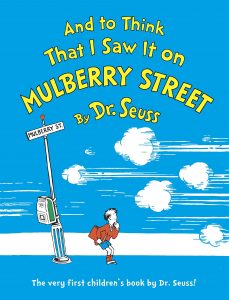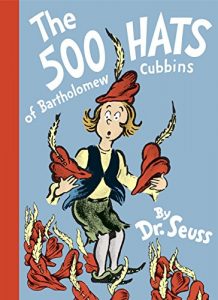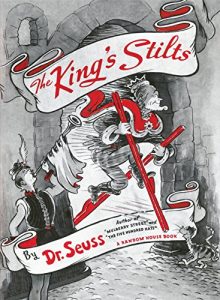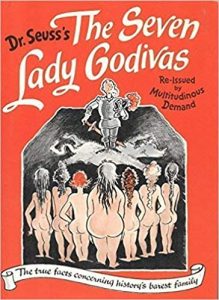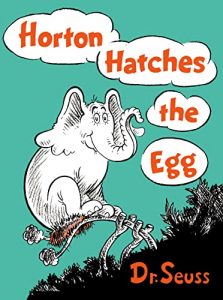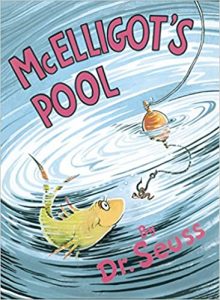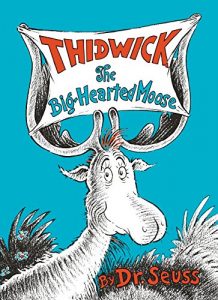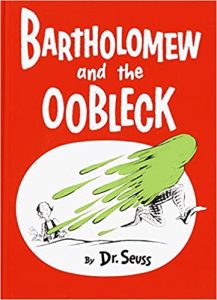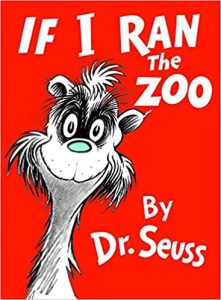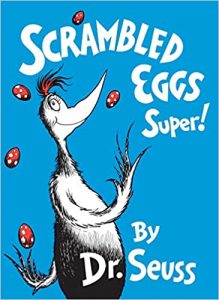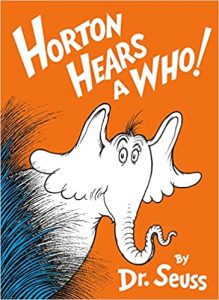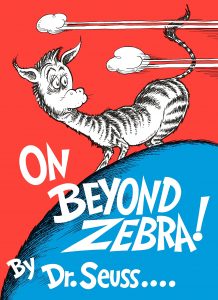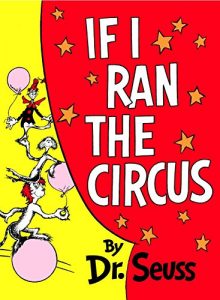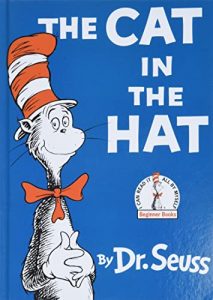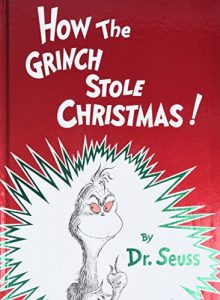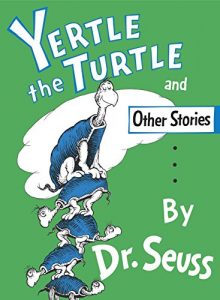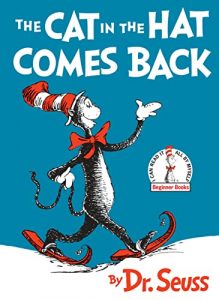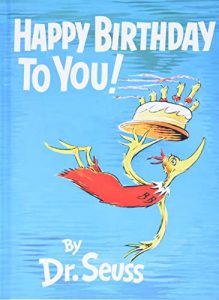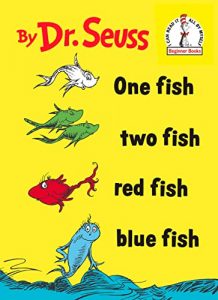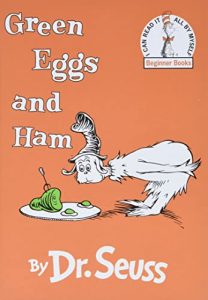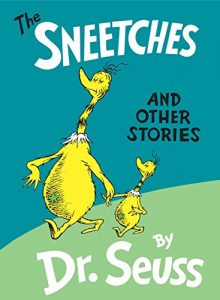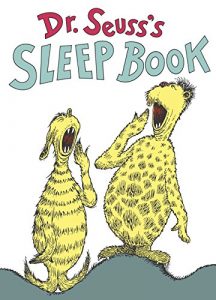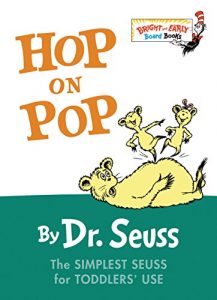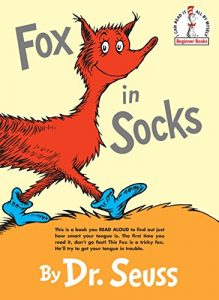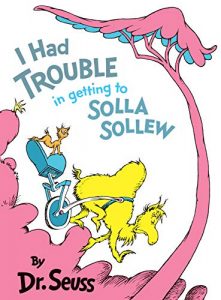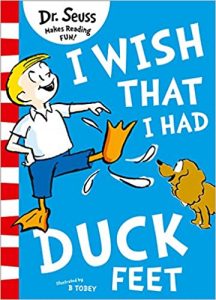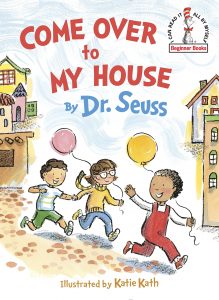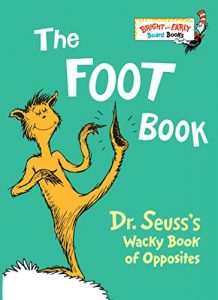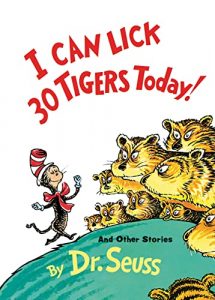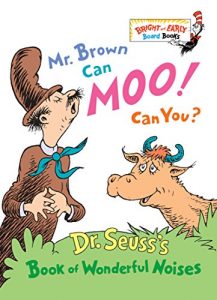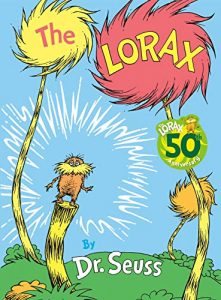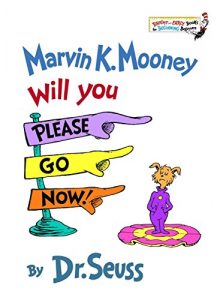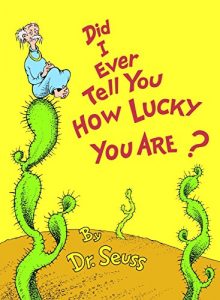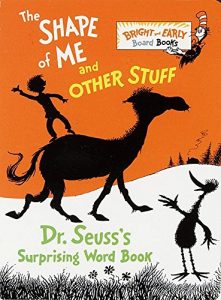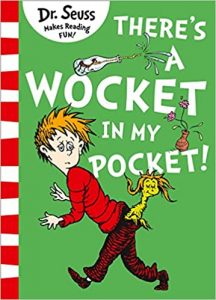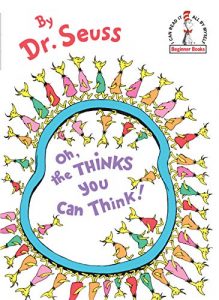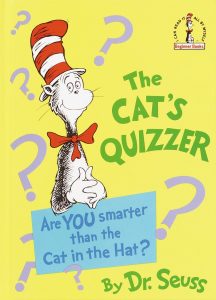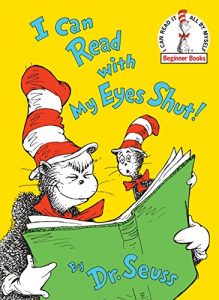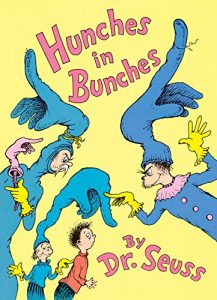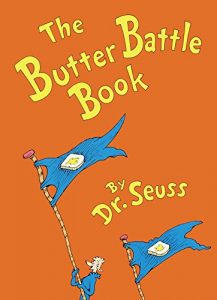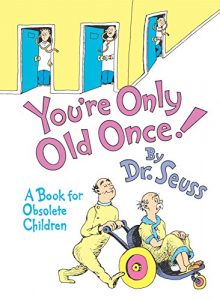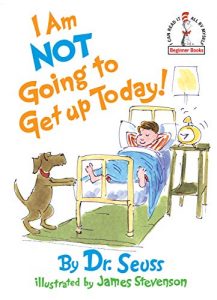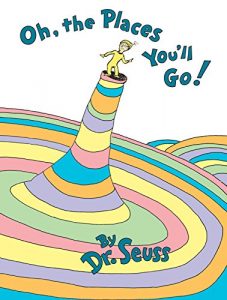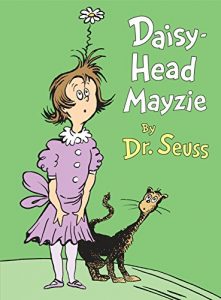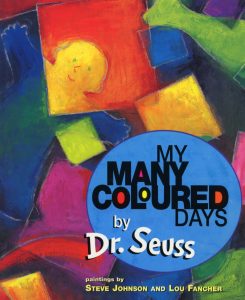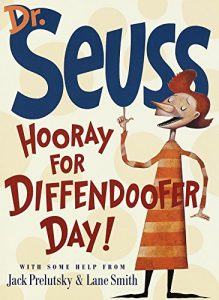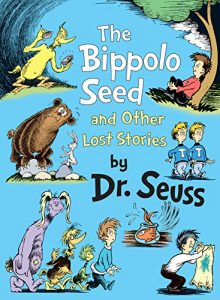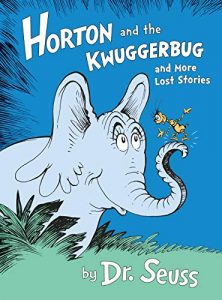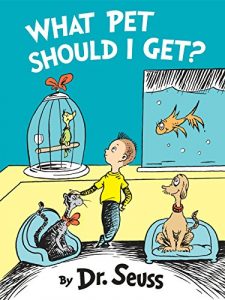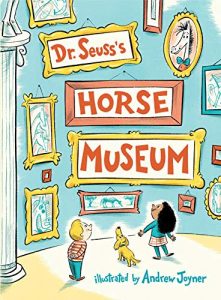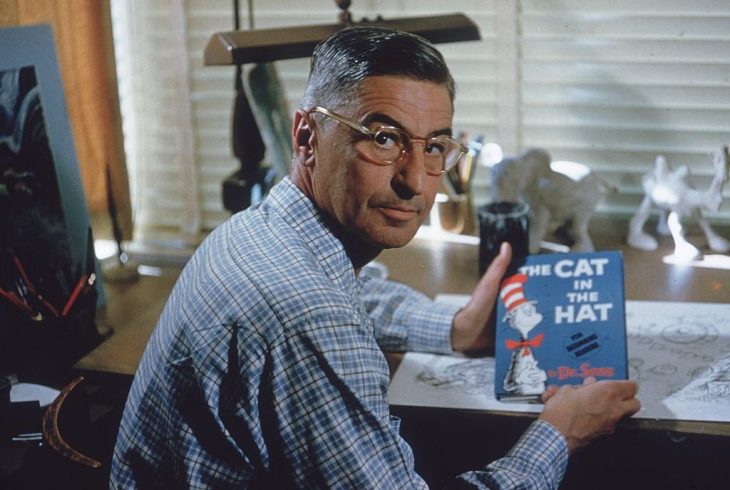
Theodor Seuss Geisel, better known as Dr Seuss, stands as one of the most famous children’s book writers in the world. He published many different books in his lifetime, so much so that it can be difficult to decide which to read first. To help you, we’ve prepared a proper list of Dr Seuss’s books in the order to read them.
The Pocket Book of Boners (1931)
The first of Dr Seuss’ many written works featuring illustrations by himself. Its name references its contents, with “boner” a common slang in the early 20th century for a silly mistake. The book contains 22 different boners, along with many jokes and humorous notes by Dr Seuss, each composed of four sentences, at most.
One of those publications took place in 1941, before the start of WWII, which made the book a popular distraction for soldiers during the war. In fact, by the end of the war, The Pocket Book of Boners had an estimated 1.34 million copies around the world.
And to Think I Saw It on Mulberry Street (1937)
Dr Seuss’ first-ever children’s book tells the story of a young boy named Marco as he walks down the titular Mulberry Street. Marco sees something on the way that he wants to tell his father on coming home. As he walks down the street, though, he embellishes his story, turning a pedestrian sight into a fantastic and dream-like parade. But in the end, he simply tells his father what he actually saw: a simple horse-drawn wagon.
And To Think I Saw It on Mulberry Street received a warm response from critics at its first publication, although it initially suffered from low sales. More recently, Dr Seuss’ estate withdrew the book from publication in 2021 over various racist illustrations. This caused a backlash from conservative circles, while also causing a surge in demand for second-hand copies of the book on eBay and other sites.
The 500 Hats of Bartholomew Cubbins (1938)
Set in the fictional medieval Kingdom of Didd, this book tells the story of a peasant boy named Bartholomew Cubbins. While selling berries, the king unexpectedly passes by, prompting Cubbins to take off his hat as a show of respect. However, every time he takes off his hat, another hat inexplicably appears on his head.
The king’s soldiers and servants all try to take Cubbins’ hat off his head, but a new hat keeps on appearing. Eventually, the king’s nephew simply tries to kill Cubbins, but the king stops the execution in time. The hats stopped reappearing after the 500th one, with the king buying all the hats in exchange for 500 gold coins.
Dr Seuss admitted he took inspiration for the book from his own hobby of collecting novelty hats. The 500 Hats of Bartholomew Cubbins also marked the doctor’s first experiment with storytelling in prose instead of with rhymes. Critics warmly received the book, with their only complaint focused on its short length.
The King’s Stilts (1939)
Much like Dr Seuss’ previous book, The King’s Stilts’ takes place in a fictional medieval kingdom, the Kingdom of Binn. It tells the story of King Birtram who tries to protect his kingdom from bird pests called nizzards. The nizzards feed on a ring of trees that surround the kingdom and also protect it from floods.
The king also has a habit of going around on a pair of red stilts, which exasperates his servants for how undignified they make him look. Eventually, one of the king’s servants hides the stilts, but this causes King Birtram to become depressed, and neglect his duties.
As the nizzards attack the trees in the king’s absence, a servant boy named Eric finally returns the stilts. This snaps King Birtram from his depression, and he quickly puts things back into order.
The Seven Lady Godivas (1939)
Set in medieval England, it tells the story of the historical Lady Godiva and her six sisters. The Godiva sisters constantly go around naked, claiming they see no need to disguise themselves in any way. After their father dies from a horse accident, the sisters swear to never marry, before setting out on their quest to prove the dangers of horses to their countrymen.
One of Dr Seuss’ few works explicitly meant for an adult audience, he actually hesitated to publish the book at first. His hesitation proved prescient as the book sold poorly. However, as his fame increased over the following decades, The Seven Lady Godivas received additional publications, which proved more successful than its first run.
Horton Hatches the Egg (1940)
Centered around the titular elephant Horton, Horton gets convinced by a lazy bird named Mayzie to sit on her egg. Mayzie then goes on vacation in Palm Beach, Florida, while Horton goes around the country with a circus. All that time he continues to watch over the egg, refusing to abandon it even after it puts his life at risk.
Eventually, the circus passes by Palm Beach, with Mayzie returning to demand the egg back. However, the egg hatches with an elephant-bird hybrid that sees Horton as his parent. Horton and his new child stay with the circus, leaving Mayzie with nothing.
Horton Hatches the Egg is one of Dr Seuss’ most successful works, even receiving an animated adaptation by Warner Brothers in 1942. Critics expressed surprise at Dr Seuss writing a morality tale and even found it somewhat forced. That said, they praised the story for smoothly merging comedy and morality together. Horton Hatches the Egg later became cited in various discussions covering topics ranging from adoption, Christianity, economics, and even feminism.
McElligot’s Pool (1947)
The book returns to the boy Marco from Dr Seuss’ previous work, And to Think I Saw It on Mulberry Street. Marco goes fishing at the titular McElligot’s Pool, a small and polluted pool of water. This causes a farmer to taunt Marco, but Marco responds with a fantastic imagining of the kinds of fish he might catch.
McElligot’s Pool marked Dr Seuss’ return after a hiatus of seven years. It also saw him use watercolors in his illustration for the first time. Ironically, budget limitations forced the publishing house to print the books with only half the pages colored, and the rest in black and white.
Much like And to Think I Saw It on Mulberry Street, Dr Seuss’ estate withdrew McElligot’s Pool from publication in 2021 over repeated use of the word “Eskimo”. This again caused controversy and demand for copies of the book on eBay and similar sites to spike.
Thidwick the Big-Hearted Moose (1948)
The story revolves around the titular Thidwich, a moose who lives with his herd along the shores of Lake Winna-Bango. One day, a bug asks Thidwick to let him ride on his antlers, with the moose agreeing.
However, the bug instead settles in, with other insects, later even birds. They further abuse his hospitality by damaging his antlers, and even forcing him to leave the herd. Eventually, Thidwick gets pushed to the brink of starvation, and finally gets hunted by a group of humans. In the end, though, Thidwick sheds his antlers and finally leaves, escaping the hunters who claim his antlers along with the bugs and birds living on them.
Critics quickly recognized Thidwick the Big-Hearted Moose as Dr Seuss’ lesson on the limits of hospitality. Academics also used it as a source of inspiration for discussions on squatter’s rights. It even received an animated adaptation, Welcome, made in 1986 in the Soviet Union.
Bartholomew and the Oobleck (1949)
This book saw the return of the King of Didd and the peasant boy Bartholomew Cubbins, who has become a royal page. Having grown tired of the normal weather, the king orders the royal magicians to change it. This leads to the titular oobleck raining down from the sky, delighting the king.
However, the oobleck soon proves both a nuisance and a danger, threatening to drown the kingdom in sticky ooze. In the end, the king himself stops the oobleck from raining down, after Cubbins convinces him to admit his wrongdoing in presuming to tamper with the weather.
The book became one of Dr Seuss’ biggest hits, receiving the Caldecott award in 1950 as the most distinguished children’s picture book of 1949. Scientists also later named a substance made from cornstarch and water oobleck in honor of the book. Most recently, the American web series RWBY later had a character named after oobleck, Doctor Bartholomew Oobleck.
If I Ran the Zoo (1950)
The story centers around Gerald McGrew, who visits a zoo one day. He grows bored of the usual exhibits and imagines himself in charge of the zoo. In his imagination, McGrew releases all the normal animals and replaces them with fantastic creatures from around the world.
The book has become known for featuring the first use of the word “nerd” in print, as the name of one of the animals McGrew imagined. Some of the imaginary animals in the book also later appeared in the 1975 TV cartoon, The Hoober-Bloob Highway.
If I Ran the Zoo attracted controversy in 1988, for the use of racist caricatures of Asians and Africans in many of its illustrations. These caricatures received further criticism from anti-racism activists in Canada and the USA in 2015, and again in 2019. This, in turn, later led to Dr Seuss’ estate withdrawing the book from publication in 2019.
Scrambled Eggs Super! (1953)
The book tells the story of a boy named Peter T. Hooper, particularly about his self-proclaimed talent as a cook. He boasts to his sister Liz about how he’d previously made scrambled eggs using the eggs of exotic birds from around the world.
Hooper details how he chooses which eggs to cook, as well as all his foreign friends who helped him gather the eggs. He also finishes each of his boasted recipes with the tongue-twister “Scrambled Eggs Super Dee Dooper Dee Booper Special Deluxe a la Peter T. Hooper”.
The book later became one of the books withdrawn from publication by Dr Seuss’ estate in 2021 over racist imagery. EBay also delisted the book from its products on sale for its provocative content.
Horton Hears a Who! (1954)
This book features the return of Horton the Elephant as he starts hearing what seems like a speck of dust talking to him. Horton soon discovers it’s no dust at all, but a microscopic planet with microscopic people called Whos living on it. Horton tries to tell his fellow animals about his discovery, only for them to scoff at him.
One of Doctor Seuss’ most successful works, Horton Hears a Who! became especially known for the line “A person’s a person, no matter how small”. The book later received an animated adaptation in 1970, and again in 2008. It also served as an inspiration for the Broadway musical Seussville, first produced in 2000.
On Beyond Zebra! (1955)
The book features an unnamed narrator, who has become dissatisfied with the letters of the Roman alphabet. He then proceeds to imagine new letters of his own, while also imagining a fantastic animal for every new letter.
Much like If I Ran the Zoo, many of the fantastic animals from On Beyond Zebra! later appeared in the 1975 TV cartoon, The Hoober-Bloob Highway. The book also became one of those withdrawn from circulation in 2021 by Dr Seuss’ estate over racist caricatures, particularly of Middle Eastern people. This, however, caused demand for the book on eBay and similar sites to surge.
If I Ran the Circus (1956)
The story centers around the young boy Morris McGurk, who finds an empty lot behind Mr. Sneelock’s shop. McGurk imagines himself turning the space into a circus, with the elderly Mr. Sneelock featured heavily in McGurk’s imaginary circus. This involves the old man becoming humiliated in various ways, such as having to serve 500 gallons of lemonade to the audience. However, it’s implied that towards the end of the story, McGurk might have said some of his imaginings aloud, with Mr. Sneelock looking at him suspiciously.
Critics consider If I Ran the Circus as subtle social commentary. In particular, they note how McGurk’s imaginings increasingly go out of control, reflecting Dr Seuss’ opinions on how people so easily take things to excess.
The Cat in the Hat (1957)
The book again features an unnamed main character, a young boy who with his sister Sally tries to find entertainment on a rainy day. The titular Cat in the Hat arrives and offers to entertain the children. The Cat starts with simple acrobatics, before moving to complicated games causing a mess in the house.
The Cat, however, simply fixes the house back to its normal state, before disappearing just as the children’s mother arrives. She asks them what they did before she arrived and they struggled to answer.
Dr Seuss admitted he wrote the book in response to issues over childhood literature at the time. He also admitted he made up its name by randomly choosing the first words he could rhyme together. The book became one of the doctor’s most successful works, selling over a million copies in just three years.
It also received an animated adaptation in 1971, and a live-action adaptation in 2003. The Cat in the Hat also became an iconic character in American children’s fiction, while also often symbolizes Dr Seuss himself.
How the Grinch Stole Christmas! (1957)
The most famous of Dr Seuss’ works, it tells the story of the lonely creature known as the Grinch. Living on Mount Crumpit outside of Whoville, the Grinch becomes annoyed by the noise coming from the town as it prepares for Christmas. This prompted the Grinch to steal all the Christmas presents and decorations on the night before Christmas, all to ruin Whoville’s holiday.
However, he gets the shock of his life when on the following day, the Whos continue to celebrate regardless. Realizing there’s more to Christmas than flashy decorations and expensive gifts, the Grinch returns everything he’s stolen. The grateful Whos then invite the Grinch to join them in the Christmas celebration, with the Grinch accepting.
Dr Seuss originally wrote How the Grinch Stole Christmas! as a criticism of the commercialization of Christmas and other holidays. Ironically, this book is the most adapted out of all his works. It first received an animated film adaption in 1966, followed by an animated prequel, Halloween is Grinch Night, in 1977. It also received a live-action adaptation in 2000, starring Jim Carrey as the Grinch. A musical adaptation followed in 2007, a CGI film in 2018, and the musical itself enjoyed a TV reboot in 2020.
Yertle the Turtle and Other Stories (1958)
A picture book collection of three stories, with the first featuring the titular turtle Yertle. As the King of the Pond, Yertle forces the other turtles in the pond to stand on top of each other, with Yertle standing at the zenith. This hurts the other turtles, but Yertle doesn’t care, only interested in the view on top. The angry turtles dump him, leaving him as the King of the Mud.
The second story has similar themes, following the she-bird Gertrude McFuzz as she tries to grow more tail feathers. This, however, leaves her unable to fly, and she eventually contents herself with her original tail feather. The third story revolves around a boasting competition between a rabbit and a bear, both of whom eventually lose to a humble worm.
The book caused some controversy during its publication, particularly over the use of the word “burp” which society considered rude at the time. Today, however, it has become one of Dr Seuss’ most successful works, with over a million copies worldwide.
And while it hasn’t received direct adaptations, its characters have appeared in other Dr Seuss-themed adaptations. These include the 1997 TV series The Wubbulous World of Dr. Seuss and the 2000 musical Seussical. The rock band Red Hot Chili Peppers even named one of their songs after Yertle the Turtle in their 1985 album, Freaky Styley.
The Cat in the Hat Comes Back (1958)
As indicated by the name, this is a sequel to the previous book The Cat in the Hat, and features the same characters. The titular Cat returns and accidentally causes a mess in the bathroom, which he tries to clean up. He fails, so he calls in other cats to help him, but they only succeed in making things worse.
The book originally had a planned live-action adaptation, after 2003’s The Cat in the Hat. However, that film’s box office failure caused Dr Seuss’ widow Audrey Geisel to veto any more live-action adaptations of his work.
Happy Birthday to You! (1959)
Set in the fictional land of Katroo, this book follows the Birthday Bird as he throws a birthday party for the reader. It starts at dawn, featuring fantastic gifts and food, along with encouraging praise for the reader, before ending late in the night.
Dr Seuss wrote the book as a psychological exercise meant to encourage self-actualization for his readers. He even dedicated it to the children of San Diego county, as well as to all his friends.
The book also has the distinction of his first work to ever receive a full-color publication. And while it has never received a direct adaptation, the Birthday Bird makes an appearance in the 1997 TV series The Wubbulous World of Dr. Seuss.
One Fish Two Fish Red Fish Blue Fish (1960)
The story follows a boy and a girl named Jay and Kay, who describe all their friends and pet in a rhyming poetic way, broken up at intervals by unconnected stories.
Despite its simple storyline, it has become one of Dr Seuss’ most successful works, with over six million copies worldwide in 2001. Today, it ranks 13th among the bestselling children’s books of all time. The USA’s National Education Union has even named it among their Top 100 Books for Children.
Green Eggs and Ham (1960)
The story follows Sam-I-Am, who offers the narrator a plate of the titular green eggs and ham. The narrator refuses, as he doesn’t like green eggs and ham, but Sam keeps on offering them. He also tries to get the narrator to try green eggs and ham in different places, such as their house, their car, and even on a boat. Sam also tries to get him to try them with other animals, such as a mouse and even a goat. In the end, the narrator finally gives in, and surprisingly finds himself liking the dish before thanking Sam.
Dr Seuss originally published the book as a beginner’s book, meant for children just starting to read. In fact, the book’s vocabulary has a deliberate limit of just 50 words, which Dr Seuss admitted resulted from a bet with his publisher.
The book has since become very successful, selling over eight million copies worldwide by 2014. Even before that, in 2012, the Scholastic Parent & Child magazine in the USA named it among their Top 100 Books for Kids. It also later inspired a TV series on Netflix in 2019.
The Sneetches and Other Stories (1961)
This book features a collection of four different stories that follow the same theme of the importance of compromise, diversity, and tolerance. Dr Seuss described them all as satires on the idea of racial and cultural discrimination. He admitted that he took the inspiration for the story from his own opposition to antisemitism.
The first story features the titular Sneetches, a group of bird-like creatures. Some of them have star-like symbols on their belly, who discriminate against those without them. This allows a conman named Sylvester McMonkey McBean to scam them all out of their money. Left penniless, the Sneetches finally find common ground and reconcile with each other regardless of their appearance.
The second story follows a pair of creatures called the Zax. One of them wants to go north, while the other wants to go south, but they both stand in each other’s way, leaving them stuck in place. The third story follows Mrs. McCave and her family’s resulting problems from naming all 23 of her sons, Dave. The final story follows an unnamed man trying to confront his fears, specifically of an empty pair of pants.
Dr. Seuss’s Sleep Book (1962)
The story follows an unnamed reporter as he reports on various sleepers around the world. He starts with a bug named Van Vleck, before moving on to people in imaginary places such as Herk-Heimer Falls, Krupp Castle, Culpepper Springs, and Mercedd.
The reporter also reports on the sleeping habits of fantastic creatures, such as the Collapsible Frink, and unusual sleeping habits like sleepwalking or talking while asleep. The reporter finishes his report by wishing the reader good night.
Critics noted early on how the book doubles as both a bedtime story and an education tool. They point to parts of the book which describe simple hygienic practices before going to bed. Dr Seuss was praised for teaching children about various sleeping conditions and habits in a way that’s both easy to understand and engages their attention.
Hop on Pop: The Simplest Seuss for Youngest Use (1963)
The book features a collection of simple poems, meant to teach children how to read in a fun and engaging way. Dr Seuss also originally included a pun about contraception among the poems, to see whether or not his publisher actually reads his work. This led to the pun getting edited out to avoid controversy.
The book has since become commonplace in elementary schools worldwide, as well as in libraries’ children’s sections. The USA’s National Education Association (NEA) even listed it among their Teachers’ Top 100 Books for Children in 2007. Even before that, former US First Lady Laura Bush publicly called the book her favorite children’s book. It also inspired a project in Laos, Big Brother Mouse, to produce a similarly-styled book, The Polar Bear Visits Laos.
Ironically, some critics later called for the Toronto Public Library to withdraw it from circulation in 2013. They claimed the book encouraged childhood disobedience and even violence against parents. The library, however, rejected their demands, and instead praised the book for its fun way of teaching children reading skills.
Fox in Socks (1965)
The story follows the titular fox wearing a pair of socks, simply named Fox, as well as his friend, the dog Knox. Fox describes various objects they encounter in tongue-twisters, starting with a box and a pair of socks. The tongue twisters grow more complicated the further they go along, with Knox increasingly frustrated over time. Eventually, he snaps and traps Fox inside a bottle, before surprising him with a tongue-twister of his own. Knox then thanks Fox for the fun, before leaving him in the bottle.
Critics had a somewhat mixed reception on the book’s publication, on one hand praising the book’s fun tongue-twisters. But on the other hand, claiming the same tongue-twisters made no sense without illustrations to go with them.
One of the tongue-twisters later received an adaptation as part of the 1975 TV cartoon, The Hoober-Bloob Highway. The book also received a translation into Hebrew in 1980, although it required some tongue-twisters to get rewritten or even replaced entirely.
I Had Trouble in Getting to Solla Sollew (1965)
The story follows an unnamed narrator who first trips on a rock and gets bitten by various animals. He heads for the city of Solla Sollew, which has a reputation as a trouble-free city. However, he finds the way to Solla Sollew filled with even more trouble, at one point even getting conscripted into the army.
By the time he reaches Solla Sollew, he finds he cannot enter because the city has only one gate. That same gate cannot open, because an animal has built a nest in its lock. The doorman decides to head for another trouble-free city and invites the narrator to join him. However, the narrator decides to just go home and face life’s troubles instead of trying to fight them.
The book makes up one of the story arcs of the 2000 musical, Seussical, with its own song describing Solla Sollew. Much like in the book, Solla Sollew gets described as a dreamlike place where people live happily forever. However, that same song also describes the city as impossible to reach, as it disappears when people even get close to it.
I Wish That I Had Duck Feet (1965)
The story follows an unnamed boy, who wishes he has duck feet and imagines all the things he could do with them. He then wishes to replace other body parts with their animal counterparts and thinks about the fantastic ways he could use them for. He later realizes the problems he’d face if his wish came true, and in the end, contents himself with his human body.
I Wish That I Had Duck Feet marks the first book since The Pocket Book of Boners that Dr Seuss published under a different pen name.
Come Over to My House (1966)
Similar to I Wish That I Had Duck Feet, the book attributed authorship to Theo LeSieg instead of Dr Seuss. He also had the illustrations done by Richard Erdoes instead, and for publications from 2016 onward, by Katie Kath.
The book itself consists of descriptions of the different ways people decorate and furnish their homes around the world. These include things like wooden pillows in Japan and hot springs in Polynesia. Other parts of the book describe different kinds of food around the world, and even children’s games. Dr Seuss published the book as one of his beginner’s books, meant for children new to reading.
The Foot Book (1968)
After three years, Dr Seuss returned to his most famous pen name, while also making his book illustrations once again. In The Foot Book, Dr Seuss describes various fantastic animals and the different kinds of feet they have between them.
As one of his beginner’s books, he used the book as a way to teach children how to read, as well as the concept of opposites in a simple and fun way. However, the book itself has a tragic background, with Dr Seuss writing it as a way of coping with the death of his first wife, Helen Palmer Geisel. It became one of his most successful works, evident by its 52nd reprint in 1997. It even inspired Big Brother Mouse in Laos to produce a similarly-styled work, Baby Frog, Baby Monkey.
I Can Lick 30 Tigers Today! and Other Stories (1969)
This is a collection of various stories, the first of which sees the return of the Cat in the Hat. The story boils down to the Cat’s young self or son boasting fighting and winning against 30 tigers. In the end, however, the Cat simply uses various excuses to avoid actually fighting and wins by disqualifying all the tigers instead.
Other stories in the book include King Looie Klatz, which has similar themes to Yertle the Turtle. In particular, it criticizes the flaws of a rigid and hierarchical society and pushes the advantages of self-reliance. There’s also The Glunk That Got Thunk, which revolves around the power of a runaway imagination.
My Book about ME (1969)
This book makes up one of Dr Seuss’ most unique works, as it doesn’t have a plot. Instead, the Doctor left parts of the book blank, with the reader meant to fill them with their ideas and answers. This reflects the title of the book, as well as the way Dr Seuss had its attribution done. Specifically, he attributed it to “Me, myself with some help from my friends, Dr Seuss and Roy McKie.” Once filled in, the book’s story essentially forms a profile of the reader, based on their perceptions. In fact, the book has very few illustrations, deliberately done by Dr Seuss to limit influencing the reader’s responses.
Mr. Brown Can Moo! Can You?: Dr. Seuss’s Book of Wonderful Noises (1970)
The story follows the titular Mr. Brown, who can mimic the sounds made by various animals and objects. These include not just a cow’s mooing, but also the buzzing of a bee, and even the popping of a cork from a bottle. Throughout the story, the narrator challenges Mr. Brown to mimic the sound of other animals and even natural phenomena, like a lightning strike. However, Mr. Brown manages to meet every challenge, mimicking the sounds they should have.
Dr Seuss wrote the book to introduce children to the concept of onomatopoeias. He finishes the story with a challenge for the reader to try and make the same noises themselves. He also included a helpful list of all the onomatopoeias used in the story at the end of the book.
The Lorax (1971)
The story follows an unnamed boy as he listens to the story of the Lorax, which once lived in a nature-filled valley. One day, however, a man named the Once-ler came to the valley and chopped down a Truffula tree, which only grows in the valley. He then used the tree to make a kind of clothing he called Thneed, all the while ignoring the Lorax’s protests. The Thneed makes the Once-ler a fortune, so he proceeds to make more of them, at the Lorax’s valley’s expense.
Eventually, however, he chops down all the Truffula trees, leaving him unable to make more of the Thneed. The Once-ler’s business collapses, with the Lorax leaving but not before giving him a cryptic message. In the present, the Once-ler gives the boy a Truffula seed and asks him to grow a new Truffula forest so the Lorax can return.
Dr Seuss personally considered The Lorax his favorite out of all the books he’s written. Ironically, he admitted he wrote the book during an angry time in his life, using it to express his anger at the economic and industrial issues of the time. Environmentalists today express misgivings that children can understand its message, but admit it works as an introduction to the effects of environmental exploitation.
The Lorax received an animated TV musical adaptation only a year after its publishing, in 1972. It also later received a CGI film adaptation in 2012, which was met with mixed reviews from critics but dominated the box office during its release. The CGI film adaptation also doubled as a posthumous celebration of Dr Seuss’ 108th birthday.
Marvin K. Mooney Will You Please Go Now! (1972)
The story follows an unnamed narrator, as well as the titular Marvin K. Mooney, an anthropomorphic dog in a set of violet pajamas. The narrator repeatedly tries to get Mooney to leave, but Mooney refuses, insisting it isn’t time yet. This annoys the narrator, who gets increasingly frustrated as the story progresses. Hand gestures and finger-pointing soon join his demands that Mooney leave, and his voice steadily rises.
In the end, the narrator gets reduced to shouting, shown in the story by his lines rendered in all-caps and finished with exclamation points. Mooney finally leaves but gets the last word in by saying he’s leaving only because the time has come.
Marvin K. Mooney Will You Please Go Now! would later become politicized, and with Dr Seuss’ approval, even. During the Watergate Scandal, Dr Seuss allowed the book to appear in newspaper editorials. However, its title instead read as “Richard M. Nixon Will You Please Go Now!”
Later on, in 2008, critics of Hillary Clinton suggested using a similar illustration to show disapproval towards her prolonged campaign against Barack Obama in the Democratic Primaries. British MEP Daniel Hannan referenced the book during the 2009 European Parliament Elections against Gordon Brown. It also saw use against Hosni Mubarak during the 2011 Egyptian Revolution, and against Donald Trump in both 2016 and 2020.
Did I Ever Tell You How Lucky You Are? (1973)
This is a collection of stories told from the perspective of a wise old man who tells them to an unnamed man he just met. Each story revolves around a wretched character who finds themselves in an especially unfortunate situation. Each story ends with the old man telling the other man, and thus the reader, to consider themselves very lucky in comparison.
The book would later become referenced by Alyssa Rosenburg in The Washington Post in 2021, over Dr Seuss’ estate withdrawing various works over their content. In particular, she described Did I Ever Tell You How Lucky You Are? as especially relevant today, for how it pointed out the silly and unimaginative nature of adults in comparison to children.
The Shape of Me and Other Stuff (1973)
This is one of Dr Seuss’ more unusual works, resulting from how he illustrated the book completely in silhouettes. He did so to complement the story, which aims to teach children the various shapes and sizes of people, animals, and objects. As such, he included this book in his Beginner Books, aimed at children only just starting to learn how to read.
The story itself follows his usual style, with two unnamed children going on a fantastic voyage around the world. As they do so, they learn all about strange new things, which they describe in the form of the shapes they have.
There’s a Wocket in My Pocket! (1974)
The book follows an unnamed boy, who spends the story describing the strange and fantastic creatures living in his house. The wocket makes up one of those, living in his pocket. Other creatures include the yeps living on the house’s steps, the wasket living in his basket, and a yottle in a bottle.
The book became an internet hit in 2018 after rapper Win Nevaluze gave it a rap rendition to the tune of Walk It Talk It.
Great Day for Up! (1974)
This is a collection of poems and short stories by Dr Seuss, each following the various meanings of the word “up”. The stories generally have uplifting styles, described by the Doctor as a celebration of life itself.
The book is also one of the few where he let someone else draw the illustrations. In this case, Quentin Blake drew the illustrations, as evident by his name on the cover. Dr Seuss also included it among his Beginner Books and intended for it to teach children about how words can have many different meanings.
Oh, the Thinks You Can Think! (1975)
The unnamed narrator starts the story by thinking about ordinary animals like birds and horses and soon challenges the reader to imagine something completely different instead. They go back to ordinary things, but with a twist. The narrator tells the reader to imagine a dessert, but not the exact kind of dessert, encouraging the imagination to go wild.
The book’s own illustrations follow the trend, first by seemingly defying gravity on the pages, before the text inverts, reading from right to left instead of left to right. Dr Seuss wrote the book as an encouragement for the readers to let their imagination flourish, as reflected in its themes. It became a major inspiration for the 2000 musical Seussical, with a song in the production taking its name straight from the book itself.
The Cat’s Quizzer (1976)
Featuring the return of the Cat in the Hat, who this time interacts with the reader directly. He introduces Ziggy and Zizzy, who both scored 100 percent answering the book’s questions. Paradoxically, however, the Cat then says they also got all the answers wrong. The Cat then challenges the reader to see if they’re smarter than Ziggy and Zizzy, before asking the book’s questions. The questions become increasingly confusing over the story, to the point that even the Cat gives up in the end.
Dr Seuss’ estate included The Cat’s Quizzer among the books they withdrew from publication in 2021. They did so over the illustration of a stereotypically yellow-skinned man in a coolie hat. eBay later delisted the book for the same reason, but only after sales of the book ironically surged in direct response to its withdrawal.
I Can Read with My Eyes Shut! (1978)
This book once again features the Cat in the Hat, who spends the story teaching his son, the Young Cat, how to read. The Cat also shows the Young Cat how reading doesn’t just help him learn many useful things, but how it also serves as a wonderful way to pass the time.
The title itself references how the Cat shows his son at one point how he can read with only one eye open. However, this strains the eye, and thus it’s always better to read with both eyes open.
This plot point actually references Dr Seuss’ own failing vision at the time, which ironically served as his inspiration for the book. He also dedicated this book to his ophthalmologist, David Worthen.
Oh Say Can You Say? (1979)
The last of Dr Seuss’ Beginner Books where he drew the illustrations. This includes a collection of 22 tongue twisters, each with its own story. The book’s introduction features Hooey the Parrot, who appears reading the book and warning the reader of its contents.
Among the stories, there’s Fresh, Fresher, and Freshest, which features a diner owner named Finney as he tries to sell three platters of fish, each supposedly fresher than the other. There’s also Bed Spreader, Bread Spreader, which follows an unnamed protagonist spreading butter on bread while sitting on a bedspread. The narrator tells him to take care, as he could accidentally spread butter on his bedspread instead.
Hunches in Bunches (1982)
The story follows an unnamed boy, as he’s confronted with the problem of what to do with his free time. Each hunch then appears in the form of strange and fantastic creatures with glove-like hats. They each offer a possible solution to the boy’s dilemma, but more often than not end up contradicting each other.
These solutions include going outside to play, staying in his room and doing his homework, or even going to have a pizza for a snack. The boy himself finds it difficult to determine which hunch has the right idea and must make the choice of what to do by himself.
The Butter Battle Book (1984)
The story is set in a fictional world divided between the Yooks and the Zooks, whose only difference involves which side of bread should get spread with butter. The Yooks like their bread with the butter on the upper side, while the Zooks like the opposite.
This leads both sides to separate each other with a long wall that stretches across the world. They also developed a series of increasingly-dangerous weapons, always in response to each other. Eventually, both the Yook and the Zook generals end up in a standoff, waiting to see who’ll drop bombs first.
Dr Seuss wrote the book as a criticism of the Cold War, in light of then-US President Ronald Reagan’s hawkish foreign policy. In fact, he wrote the weapons competition between the Yooks and the Zooks as a direct satire of the nuclear arms race between the USA and the Soviet Union. Even the book’s own ending references how the only thing keeping war from breaking out involves both sides waiting for the other to fire first.
You’re Only Old Once! (1986)
The story follows an unnamed old man as he visits the Golden Years Clinic over a simple medical issue. However, he finds himself forced to wait a long time for service, and when it finally comes, he has to undergo a series of complicated and long-winded tests.
Dr Seuss wrote this book in light of his experiences after suffering from a long series of illnesses in his old age. In particular, he wanted to highlight the inefficiencies of the healthcare system, and how it takes so long just to get help. This also led him to publish the book as one for adult audiences, the first since The Seven Lady Godivas.
Ironically, Dr Seuss found it difficult to write You’re Only Old Once!, as he needed to cater to an adult audience. He later described adults as “obsolete children…the hell with them.”
I Am Not Going to Get Up Today! (1987)
The last of Dr Seuss’ Beginner Books follows an unnamed boy who decides to sleep in for the day. He boasts that nothing will make him get up, with the boy vividly imagining the various things that could try to make him do so. These include random noises, his family, their neighbors, the paparazzi, the police, and even the US Marines. In the end, his family gives up on making the boy get up and offers his breakfast to a policeman. The policeman accepts and eats the boy’s breakfast in the boy’s own room much to his shock and surprise.
Oh, the Places You’ll Go! (1990)
The last book that Dr Seuss published before his death follows an unnamed protagonist who leaves town. As he does so, he finds himself drawn into fantastic places and situations, before ending up in what’s called “The Waiting Place”. The people already there describe it as an ominous place where they all wait for something to happen.
Undaunted, the protagonist moves on, drawn by the prospect of seeing more wonderful things and visiting more fantastic places. The story then ends on an open note, with the reader left wondering what could happen in the future.
Oh, the Places You’ll Go! became The New York Times’ bestselling hardcover book in the same year of its publishing. Over the following decades, it’s also become a popular graduation gift for students of all levels. It also later became the USA Today’s bestselling book first in 1997, and again in 2021.
Oh, the Places You’ll Go! became involved in legal controversy in 2016, over a planned parody by former Star Trek writer David Gerrold. This led to a court case by Dr Seuss’ estate, with the US District Court ruling in the parody’s favor in 2018, and again on appeal in 2019. However, the second appeal in 2020 saw the Ninth Circuit Court of Appeals reverse the earlier rulings, and rule in favor of Dr Seuss’ estate.
Daisy-Head Mayzie (1995)
The first of several books published posthumously for Dr Seuss, but based on his notes and featuring his drawing style. Daisy-Head Mayzie follows the titular girl Mayzie, who inexplicably sprouts a daisy on her head. This causes her problems at first, but then an agent takes notice and uses it instead to turn her into a celebrity.
However, Mayzie becomes overwhelmed by her fame, causing the Cat in the Hat to come and help. He convinces her to give up on her fame and to just go home, with the daisy eventually wilting and disappearing.
Daisy-Head Mayzie received an animated adaptation in the same year of its publication. Ironically, it aired in February 1995, five months before the book’s official release in July 1995. A mascot of Mayzie later appeared at Universal Studios’ Islands of Adventure theme park.
My Many Colored Days (1996)
Based on a manuscript by Dr Seuss dating back to 1974, it describes several days in rhymes and different colors, with each of the latter referencing an emotion. Dr Seuss also describes the story as an expression of hope on the doctor’s part. In particular, he expresses hope in future artists confident in their own style, independent of the Doctor’s influence.
Dr Seuss also described the planned book as one that celebrates beautiful illustrations and vivid colors. My Many Colored Days later became designated by the NEA in 2007 as among its Teachers’ Top 100 Books for Children.
Hooray for Diffendoofer Day! (1998)
The book takes inspiration from fragmentary ideas and poems by Doctor Seuss shortly before his death. Jack Prelutsky and Lane Smith expanded on those and published the book in Dr Seuss’ name. It follows the titular Diffendoofer School in Dinkerville, which has a strange reputation for its fun but unusual teachers. This, in turn, makes it popular among students, as the teachers make the educational experience fun and interesting.
However, the students must earn high grades in the standardized tests on their turn. Otherwise, Diffendoofer School stands the risk of getting demolished.
The Bippolo Seed and Other Lost Stories (2011)
This book collects seven stories previously published by Doctor Seuss as separate stories in the magazine Redbook from 1948 to 1959. These include the titular story “The Bippolo Seed”, which follows a duck named McKluck who finds a rare Bippolo seed. The seed supposedly has the power to grant wishes, but he loses the seed wishing for more than he needs.
There’s also “Gustav, the Goldfish”, telling the story of a boy who feeds the titular goldfish until it becomes as big as a cellar. It also actually previously received an expansion in 1961, A Fish Out of Water, by Helen Palmer. As none of these stories had previously appeared in book form, the publisher described their collective publishing as equivalent to finding buried treasure.
Horton and the Kwuggerbug and More Lost Stories (2014)
Similar to the previous book, this book collects another four stories originally published in Redbook magazine from 1950 to 1955. The titular story features the return of Horton the Elephant, who agrees to help a Kwuggerbug find the beezlenut tree.
Various dangers lie on the way to the tree, but the Kwuggerbug promises Horton half the nuts in return for his help. In the end, they reach the tree, with Kwuggerbug trying to swindle Horton out of his promised reward. However, Horton accidentally sneezes, which causes his promised half of the bugs to fall from the tree into his possession.
What Pet Should I Get? (2015)
This story features the return of Jay and Kay from One Fish Two Fish Red Fish Blue Fish. The siblings want to buy a new pet and spend the story considering various animals before deciding at noon.
Dr Seuss originally wrote the manuscript for this story between 1958 and 1962 but left it unfinished. His widow later rediscovered it in 2013, with publisher Cathy Goldsmith reconstructing the story over the following years before finally publishing it at last.
Dr. Seuss’s Horse Museum (2019)
The book follows several students as they tour an art museum, which primarily features artwork about horses. Most of them reference real-life artists, such as Rosa Bonheur, Alexander Calder, Franz Marc, and even Pablo Picasso. Other works in the museum include characters by Dr Seuss, such as the Grinch and the Cat in the Hat.
Much like What Pet Should I Get?, Dr Seuss actually wrote this story himself only to leave it unfinished when he died. When the Doctor’s widow rediscovered the manuscript, she found it nearly completed, lacking only illustrations to finish it. So far, it remains the last posthumously-published work by Doctor Seuss as of 2022. However, Dr Seuss’ estate maintains that they will continue to publish additional works based on his notes and manuscripts in the future.
Was this page helpful?
Our commitment to delivering trustworthy and engaging content is at the heart of what we do. Each fact on our site is contributed by real users like you, bringing a wealth of diverse insights and information. To ensure the highest standards of accuracy and reliability, our dedicated editors meticulously review each submission. This process guarantees that the facts we share are not only fascinating but also credible. Trust in our commitment to quality and authenticity as you explore and learn with us.


